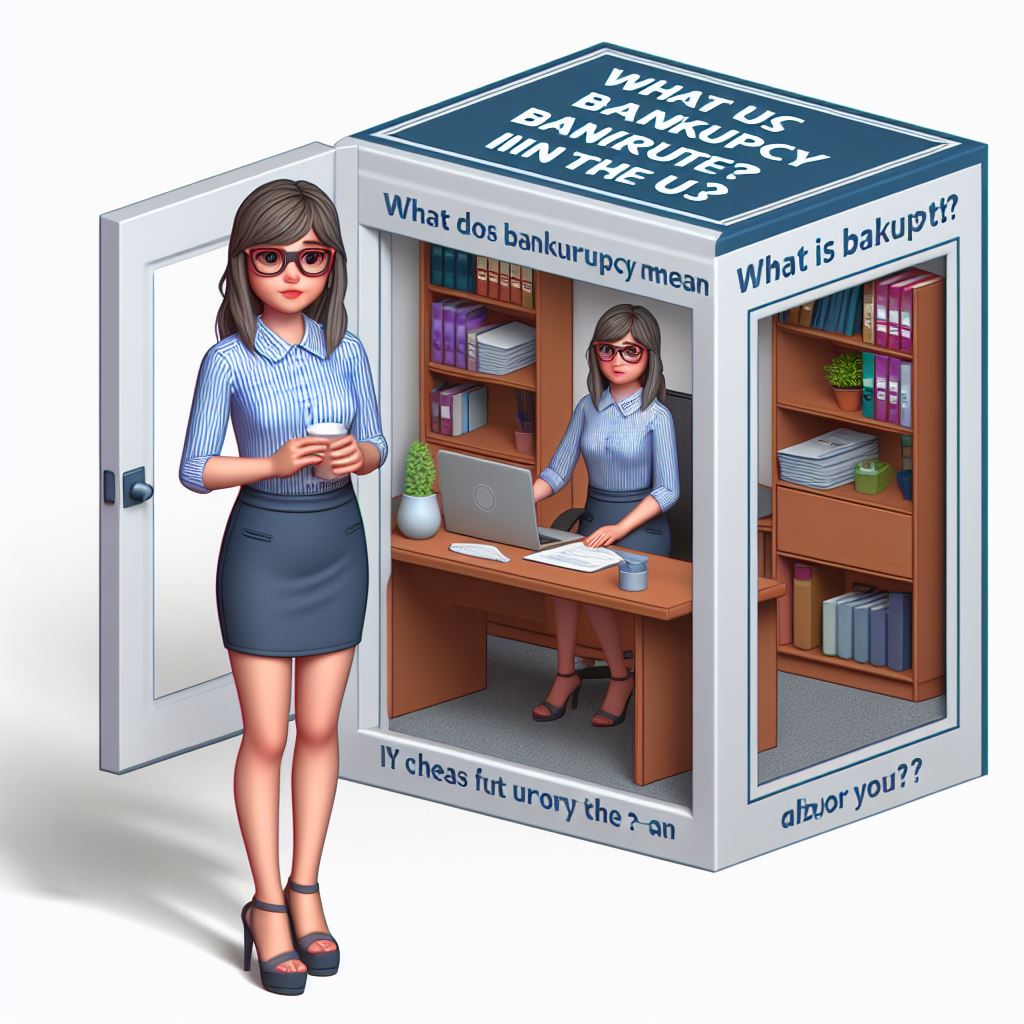
Obligation can feel like a stifling weight. Hospital expenses, Mastercard obligation, surprising costs – they all stack up, leaving you considering how you’ll at any point excel. On the off chance that you’ve arrived where you can’t pay your obligations, petitioning for financial protection in the US may be a feasible choice. Yet, bankruptcy’s meaning could be a little clearer.
This far reaching guide jumps profound into the universe of US liquidation, making sense of its motivation, various parts, and the means associated with the interaction. We’ll likewise investigate the effect of insolvency on your credit and funds, and give assets to assist you with exploring what is happening.

Grasping Liquidation: A New beginning or a Monetary Dark Opening?
Liquidation is a lawful interaction regulated by the government courts that permits people and organizations to acquire help from overpowering obligation. It offers a new beginning by either releasing (taking out) some or your obligations in general, or by making an organized reimbursement plan.
There are two fundamental objectives of chapter 11:
- Obligation Relief: This is the essential target for most people seeking financial protection. By releasing specific obligations, you’re not generally lawfully committed to reimburse them. This can give critical monetary help and permit you to reconstruct your credit after some time.
- Obligation Reorganization: at times, liquidation permits you to make a sensible reimbursement plan under court watch. This can be useful on the off chance that you have a consistent pay however essentially can’t manage the cost of your ongoing least installments.
It’s vital to comprehend that insolvency is certainly not an enchanted arrangement. While it can give help, it likewise accompanies results, remembering an adverse consequence for your FICO rating for a considerable length of time.
Various Sorts of Liquidation: Picking the Right Part

US liquidation regulation frameworks various parts, each with explicit qualification necessities and systems. The most widely recognized sections for people and families are:
- Section 7: This is the most well-known kind of liquidation for people. It includes exchanging non-excluded resources (those that can’t be safeguarded by regulation) to take care of banks a part of what they’re owed. Any leftover obligation is commonly released.
- Part 13: This section permits people to make a court-endorsed reimbursement plan, typically enduring 3-5 years. During this period, you’ll make regularly scheduled installments to a court-delegated legal administrator who circulates the assets to your loan bosses. After effectively finishing the arrangement, most excess obligations are released.
Here is a table summing up the vital contrasts between Part 7 and Section 13:
| Highlight | Section 7 | Part 13 |
|---|---|---|
| Obligation Release | Indeed, for most debts without collateral | Indeed, for most leftover obligations after the reimbursement plan |
| Resource Liquidation | Indeed, for non-excluded resources | No, you keep your resources |
| Reimbursement Plan | No | Indeed, long term reimbursement plan |
| Financial assessment Effect | Critical adverse consequence (7-10 years) | Moderate adverse consequence (7-10 years) |
Other Chapters:
- Part 11: This section is ordinarily utilized by organizations to redesign their obligation and keep up with tasks.
- Section 12: This part is intended for family ranchers and anglers looking for obligation alleviation.
Deciding the Right Chapter:
Picking the right liquidation part relies upon your particular monetary circumstance, pay level, and the sort of obligation you owe. Talking with a certified insolvency lawyer is vital to figure out which part best suits your requirements.
The Insolvency Cycle: What’s in store
The insolvency cycle can be intricate, however understanding the general advances can assist you with feeling more ready. Here is a worked on breakdown:
- Consultation with a Chapter 11 Attorney: This is the first and most significant stage. A lawyer will survey what is happening, make sense of your choices, and guide you through the documenting system.
- Credit Counseling: Prior to documenting, you’ll be expected to finish a credit directing course from an administration supported organization.
- Filing the Petition: Your lawyer will assist you get ready and record a request with the chapter 11 court in your region. This appeal subtleties your resources, obligations, pay, and costs.
- Automatic Stay: Once you record, a programmed stay comes full circle. This keeps banks from reaching you or making further assortment moves like claims or compensation garnishments.
- Meeting of Creditors: This is a proper gathering wherein lenders can survey your request and get clarification on pressing issues.
- Means Test (Part 7 Only): The means test is a monetary evaluation used to decide your qualification for Section 7 liquidation. It analyzes your pay to the middle pay for your family size in your state. In the event that your pay falls beneath the middle, you

What’s the significance here in the US? A Manual for Assuming Command over Your Funds (Proceeded)
The Means Test (Proceeded)
In the event that your pay falls beneath the middle, you’ll probably meet all requirements for Part 7. Nonetheless, in the event that your pay surpasses the middle, the court will dissect your extra cash to check whether you can manage the cost of a reimbursement plan under Section 13.
- Chapter 7:
- In the event that you meet all requirements for Part 7 and have non-excluded resources, a court-designated legal administrator will offer them to repay leasers.
- After resource liquidation (if relevant) and culmination of a monetary administration course, most leftover obligations are released.
- Chapter 13:
- You’ll foster a court-endorsed reimbursement plan with your lawyer, regularly enduring 3-5 years.
- During this period, you’ll make regularly scheduled installments to a court-delegated legal administrator who disperses the assets to your leasers.
- Upon effective consummation of the arrangement, any leftover qualified obligations are released.
- Debtor Training Course: Subsequent to recording, you’ll be expected to finish a debt holder instruction course to find out about private monetary administration and planning.
- Case Discharge: Whenever you’ve satisfied every one of the prerequisites of your picked section (resource liquidation in Part 7, consummation of the reimbursement plan in Part 13), the court will give a release request. This request formally sets you free from your legitimate commitment to reimburse the released obligations.
Significant Note: This is a worked on outline, and the particular systems might shift relying upon your area and monetary circumstance. Talking with a liquidation lawyer is fundamental for exploring the subtleties of the interaction.
The Effect of Chapter 11 on Your FICO assessment and Funds
Petitioning for financial protection will without a doubt adversely affect your FICO rating. The seriousness and span of the effect change contingent upon the section you record under:
- Section 7: This part commonly brings about a huge drop in your FICO rating, which can keep going for 7-10 years. Modifying your credit after Section 7 takes time and devotion.
- Part 13: While Section 13 additionally adversely influences your FICO rating, the effect is generally less serious than Part 7. Finishing a Part 13 reimbursement plan shows your obligation to monetary obligation, which can assist with further developing your FICO rating over the long haul.
Past the financial assessment, liquidation can likewise affect your funds in alternate ways, such as:
- Trouble acquiring advances or charge cards for a considerable length of time.
- Higher financing costs on future credits.
- Expanded trouble getting lodging rentals.
Notwithstanding, seeking financial protection can likewise offer critical advantages, including:
- Obligation Relief: Liquidation can give quick alleviation from overpowering obligation, permitting you to monetarily pause and rest.
- New Start: It offers a chance to modify your funds on a strong groundwork without the weight of devastating obligation.
- Stop Lender Harassment: The programmed stay keeps leasers from pestering you with assortment calls and claims.

Assets and Backing for People Thinking about Chapter 11
Assuming you’re thinking about seeking financial protection, here are a few assets to assist you with exploring the interaction:
- The US Courts Insolvency Basics: [https://www.uscourts.gov/administrations structures/bankruptcy](https://www.uscourts.gov/administrations structures/liquidation)
- Public Starting point for Credit Counseling: https://www.nfcc.org/
- American Insolvency Institute: https://www.abi.org/
Keep in mind, you don’t need to go through this alone. Conversing with a certified liquidation lawyer can give important direction and backing during this difficult time. They can survey what is going on, make sense of your choices, and guide you through the documenting system.
Conclusion
Insolvency isn’t a choice to be messed with. Be that as it may, for people battling with overpowering obligation, it very well may be an incredible asset for acquiring monetary help and restarting your monetary excursion. By understanding the various parts, the interaction in question, and the effect on your credit, you can arrive at an educated conclusion about whether chapter 11 is the ideal choice for you.
